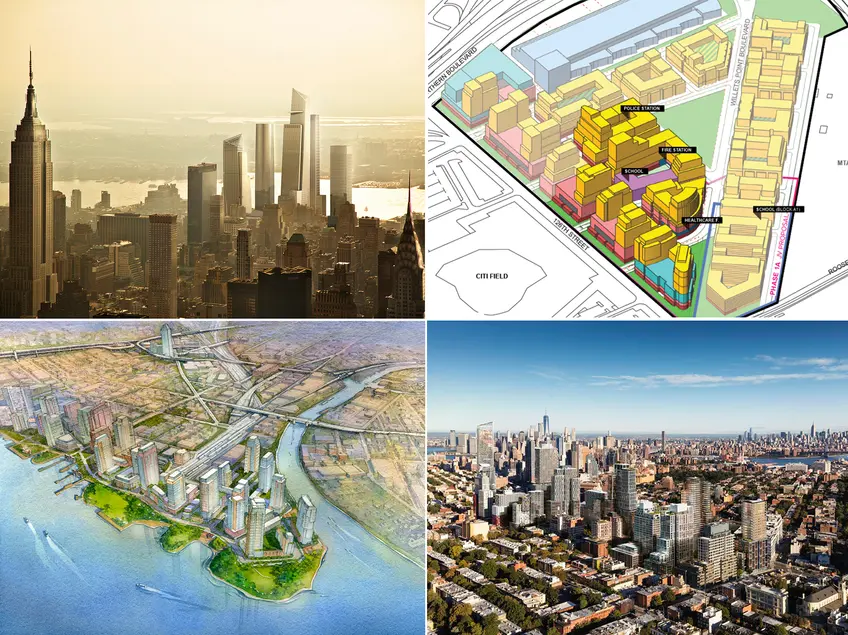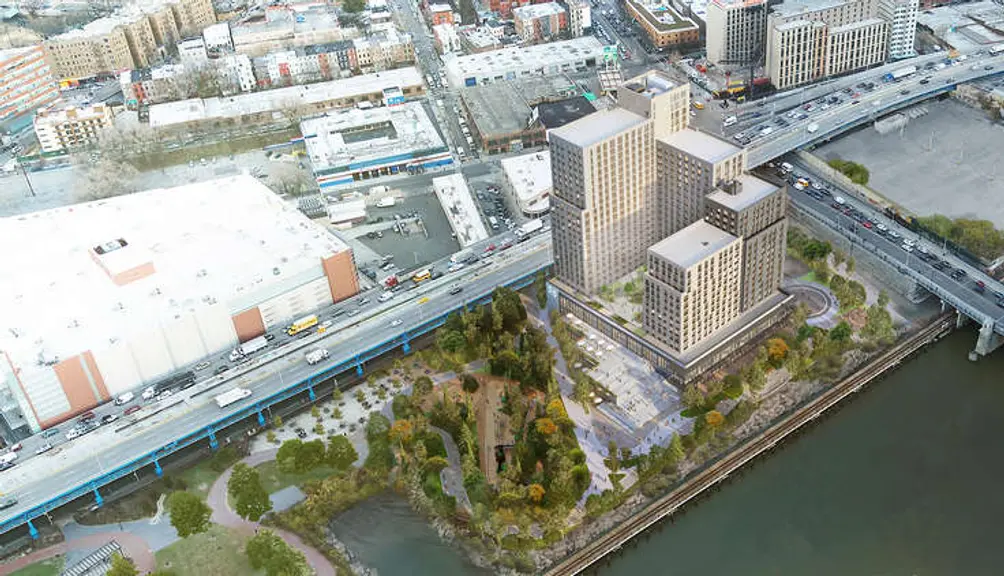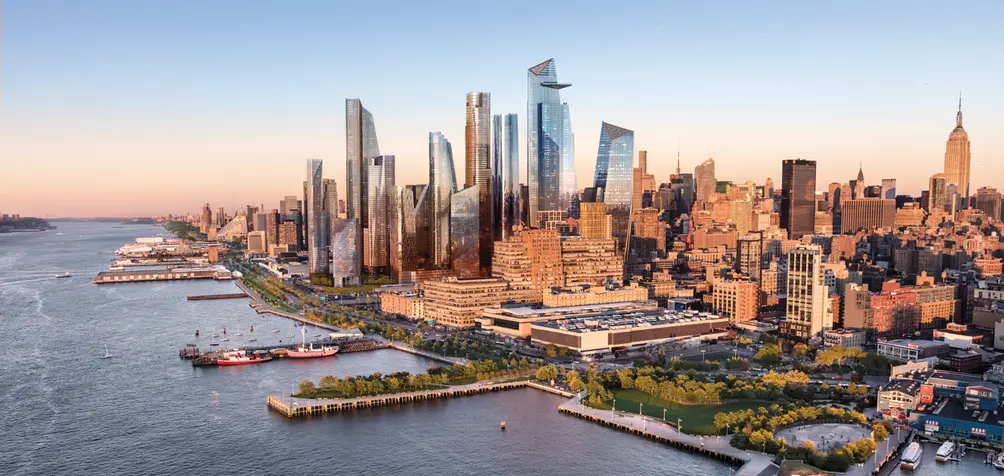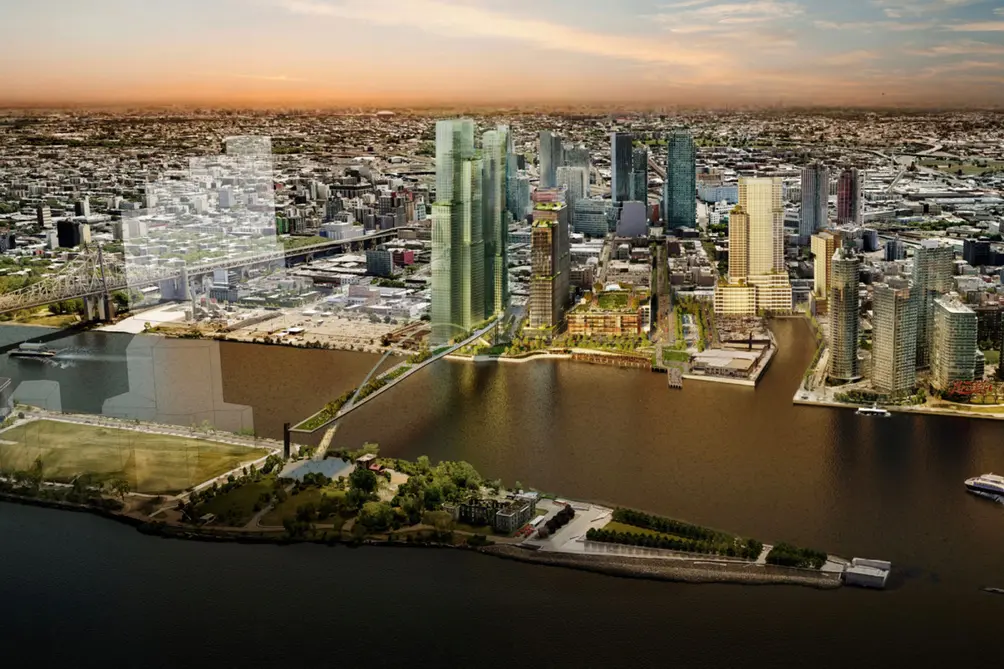 Among the city's dozens of master plans expected to bring thousands of new apartments: Hudson Yards, Willets Point, Pacific Park, and Hunters Point South
Among the city's dozens of master plans expected to bring thousands of new apartments: Hudson Yards, Willets Point, Pacific Park, and Hunters Point South
On June 22, New York City registered Democrats and Republicans have an opportunity to elect a mayoral candidate. While there are no clear winners yet, at this point, a few candidates in both parties have already separated from that large pack of people vying for the city’s top elected position. On the Democrat side, top candidates include Andrew Yang, Eric Adams, Kathryn Garcia, Maya Wiley, Scott Stringer, and Ray McGuire. On the less crowded Republican side of the race, candidates include Sara Tirschwell, Curtis Sliwa, Fernando Matteo, and William Pepitone.
With local real estate developers donating to candidates across the political spectrum, there doesn’t appear to be any consensus on which candidate will receive the most support from the real estate community. What’s clear is that some candidates are showing up as more pro-development than others. On the Democrat side, potentially development friendly candidates include Yang and Adams. On the Republican side, Tirschwell and Pepitone are likely to receive the most support from New Yorkers looking for more development and fewer restrictions.
Below, we explore the top candidates' stances on development and affordable housing, as well as their support from the real estate community. We also look at master plans for the review of the incoming mayor.
With local real estate developers donating to candidates across the political spectrum, there doesn’t appear to be any consensus on which candidate will receive the most support from the real estate community. What’s clear is that some candidates are showing up as more pro-development than others. On the Democrat side, potentially development friendly candidates include Yang and Adams. On the Republican side, Tirschwell and Pepitone are likely to receive the most support from New Yorkers looking for more development and fewer restrictions.
Below, we explore the top candidates' stances on development and affordable housing, as well as their support from the real estate community. We also look at master plans for the review of the incoming mayor.
Democratic Candidates
Andrew Yang
Officially, Andrew Yang's campaign is calling for massive repairs to the New York City’s 300 public housing developments, rezoning to allow for the creation of new affordable housing stock, an expansion of Community Land Trusts (CLTs), and an increase in both co-living and single-room occupancy (SRO) spaces. Yang has also said that he is committed to reducing homelessness, and that he is in favor of the Soho rezoning.For many onlookers, Yang’s housing plan remains vague. In early January, for example, Yang took considerable heat when he suggested that New York City might benefit from making room for more LA-inspired hype houses (for those who don’t know, these are mansions where content producers, including TikTok influencers, live and create content 24/7). In a city where over 100,000 children lack permanent housing, Yang’s proposal to support more hype houses for young influencers struck many housing advocates as out of touch.
Fortunately for Yang, as an entrepreneur himself and someone who doesn’t shy away from embracing private business solutions, Yang is one of the most development-friendly Democrat candidates on the ticket. This has already proven good for his fundraising efforts (several local real estate investors have donated to his campaign, including the founder of Iron State Holdings). Yang is likely hoping his entrepreneurial background will also win him votes among the real estate community and housing advocates on June 22.
Eric Adams
Housing is a key part of Brooklyn Borough President Eric Adams' mayoral platform. He has promised to invest in making capital improvements to NYCHA residences, and suggested selling NYCHA's air rights to local community developers at a December 2020 roundtable. He also stands in favor of rezoning wealthy areas to allow for more affordable housing, and for repurposing empty offices and hotels into residential buildings.Moreover, during Adams' time as Brooklyn Borough President, the borough witnessed an uptick in development. Adams also hasn’t had any problem collecting campaign donations from real estate investors. In fact, some of Adams’ largest donors have been real estate investors, and they include a principal at the Metro Loft Management and the Executive Vice-Chair of Cushman & Wakefield.
Kathryn Garcia
In a recent op-ed in Crain’s New York Business, Kathryn Garcia said, “Housing affordability is an existential crisis for the city” and points out that the city’s housing supply has failed to keep up with the rise in residents. To help speed up the construction process, she is in favor of behind-the-scenes changes like zoning reforms, streamlining ULURP, and creating a “fast lane” for permitting affordable and mixed-income housing projects.Ms. Garcia’s “Housing that Heals” plan calls for 50,000 units of “deeply affordable housing” (defined as affordable for those less than 50 percent of the area median income) and 10,000 units of supportive housing for people experiencing homelessness. Indeed, in response to the homelessness crisis, her plan shifts the city’s approach from a shelter-first strategy to a housing-first strategy.
 The first phase alone of Bronx Point will bring 542 permanently affordable units to the Harlem River waterfront (Rendering via S9 Architecture)
The first phase alone of Bronx Point will bring 542 permanently affordable units to the Harlem River waterfront (Rendering via S9 Architecture)
Maya Wiley
While Maya Wiley has accepted a few small donations from real estate professionals, including people who work as agents and brokers, she hasn’t been raking in large contributions from investors, and this isn’t surprising.Key components of Wiley’s housing platform include rent subsidies to address the coming eviction crisis, community land trusts, increased support for first-time homeownership, and protections for long-term homeowners. Her platform also includes a proposal to expand affordable housing stock by converting properties (e.g., hotels) vacated during the pandemic into affordable housing. Like other candidates, Wiley also understands the urgent need to make capital repairs to the existing public housing stock. To fund her proposed housing initiatives, she is looking to tax those with greater means. Wiley supports imposing a pied-a-terre tax, vacancy tax, and mansion tax or stock transfer tax.
Scott Stringer
New York City Comptroller Scott Stringer is the only front-running candidate for NYC mayor who has signed the New York Communities Change pledge to not take direct donations from real estate developers or people connected to them. A recent investigation by Politico, however, alleges that Stringer has accepted donations from a wide range of people associated with the real estate industry ($88,000 from developers, their employees, and relatives). Stringer’s donors include developer Daniel Brodsky.With or without the help of real estate developers, Stringer has certainly put housing at the center of his campaign and already managed to rile the real estate community in the process. In his detailed 47-page plan on housing, points of contention include a proposal that every new building, in every neighborhood, set aside 25% of all units for affordable housing. The units would also have to target low and extremely low-income rather than middle-income earners. Stringer’s plan also includes limiting most current tax breaks for so-called “big developers.”
Ray McGuire
On April 1, former Citigroup executive Ray McGuire released “A Home for All: The McGuire NYC Housing Plan,” an approach to solving the housing crisis. It calls for moving homeless New Yorkers out of shelters and into supportive or affordable housing, activating underutilized space like vacant lots and basement apartments as part of a goal to increase the citywide housing supply by 10 percent, building more affordable senior housing, and creating a map from renting to homeownership by expanding existing programs and creating new ones. The plan expects to accomplish these goals by reducing the cost of construction, streamlining approvals, and modernizing building codes.According to The New York Times, McGuire has enjoyed tremendous support from luminaries in business, entertainment, and real estate. They include a co-founder of Compass and Kara Ross, wife of Related’s Stephen Ross. McGuire has not shied away from the support from the business community, but it might come as a turnoff to more progressive voters.
Republican Candidates
Sara Tirschwell
Unlike other Republican hopefuls, Sara Tirschwell has a clearly defined platform on housing and development. In terms of affordable housing, Tirschwell recognizes, “The approximately 171,000 families residing in NYCHA housing deserve to live in conditions that reflect their human dignity” and proposes an expansion of the inspection program already run by the mayor’s office to deal with neglect in NYCHA buildings. She also has a concrete plan to address homelessness, including developing performance measures to assess the effectiveness of the nonprofits currently contracted to help homeless New Yorkers. On the affordable housing front, Trischwell has stated that she hopes to expand “naturally affordable housing” by “allowing market forces to operate.”In terms of development, Trischwell is a mostly development-friendly candidate. She has proposed reforms to the real estate tax system to make it easier to navigate. She has also proposed eliminating many of the dated Department of Building rules that restrict renovations. One potentially contentious proposal for developers is her plan to remove all government-provided incentives for the development and construction of luxury housing.
Curtis Sliwa
Curtis Sliwa is most well-known for founding the Guardian Angels—a citizen brigade committed to keeping New Yorkers safe. In his run for mayor, fighting crime is a significant part of his platform. He also supports overhauling the current tax system and creating more trade-based training programs for high school students, including in the building trades. His position on housing remains vague, but he has slammed his Democrat opponents for proposing potentially costly mandates.Fernando Matteo
Fernando Matteo, a former carpet business owner turned restaurateur from the Bronx, may be among the most landlord-friendly candidates on the mayoral ticket. Matteo has pledged to help landlords who, he believes, deserve as much support as tenants. It’s not clear how he plans to help landlords. In fact, he doesn’t seem to have a clear housing or development platform at all.William Pepitone
Former police officer William Pepitone’s published vision for New York City doesn’t mention housing, but it does offer clear language on crime. He has promised to “combat the anarchy and apathy that hangs over New York City” by addressing a host of issues from vandalism and loitering to graffiti and public lewdness.In a recent interview with the Gotham Gazette, though, Pepitone elaborated on his housing platform. While he supports providing housing to the homeless, he emphasizes that it will only work with accompanying programs designed to help residents eventually re-enter the workforce and find their own accommodations. When asked about affordable housing, Pepitone said he supports “more construction and housing.” Construction and its link to job creation appear to be at the center of his housing plan, which should gain Pepitone points with local developers.
 To complete the largest private development ever undertaken in the country, Hudson Yard's second phase will provide a bulk of the development's apartments. Altogether, Hudson Yards will provide 5,000 apartment units of which 20 percent of them will be designated as affordable.
To complete the largest private development ever undertaken in the country, Hudson Yard's second phase will provide a bulk of the development's apartments. Altogether, Hudson Yards will provide 5,000 apartment units of which 20 percent of them will be designated as affordable.
5 Notable Master Plans for the 2020s
Seaport City
Developed by The City of New York | Housing units TBD
Developed by The City of New York | Housing units TBD
When the memories of Superstorm Sandy and the havoc it wreaked on the city were still vivid, Mayor Bloomberg laid out a vision for “Seaport City,” a new neighborhood on landfill along Lower Manhattan from Battery Park to the Lower East Side, in June 2013. He cited Battery Park City, which was built on landfill in the 1970s and fared better than the South Street Seaport during the hurricane, as proof that it could work. A study from the NYC Economic Development Corporation (“NYC EDC”) found the idea complicated but feasible, and certain aspects have at least begun the design and approval process.
Six years later, Mayor de Blasio appeared to be revisiting that idea with his plan to “climate-proof Lower Manhattan” in response to the climate crisis and the existential threat it poses for New York. The plan recommends fortifying Lower Manhattan with grassy berms in parks and removable barriers, but the most audacious part calls for pushing the Lower Manhattan coastline out as much as 500 feet, or the equivalent of two city blocks, into the East River onto higher ground. James Patchett, president of the NYC EDC, visualizes the new land as a new park, but concedes that some real estate development might be necessary in order to finance it. This raised the eyebrows of New York magazine architecture critic Justin Davidson, who wondered if this could lead to "an offshore Hudson Yards."
Six years later, Mayor de Blasio appeared to be revisiting that idea with his plan to “climate-proof Lower Manhattan” in response to the climate crisis and the existential threat it poses for New York. The plan recommends fortifying Lower Manhattan with grassy berms in parks and removable barriers, but the most audacious part calls for pushing the Lower Manhattan coastline out as much as 500 feet, or the equivalent of two city blocks, into the East River onto higher ground. James Patchett, president of the NYC EDC, visualizes the new land as a new park, but concedes that some real estate development might be necessary in order to finance it. This raised the eyebrows of New York magazine architecture critic Justin Davidson, who wondered if this could lead to "an offshore Hudson Yards."
Gowanus Green
Developed by NYC Department of Housing Preservation and Development, The Hudson Companies, Jonathan Rose Companies, Bluestone Organization, and the Fifth Avenue Companies | 950 housing units
Developed by NYC Department of Housing Preservation and Development, The Hudson Companies, Jonathan Rose Companies, Bluestone Organization, and the Fifth Avenue Companies | 950 housing units
Full-scale dredging is underway as part of the long-awaited Gowanus Canal cleanup. When it is complete, a rezoning will allow the creation of over 8,000 new housing units in a more resilient and sustainable area. At the heart of it is Gowanus Green, a city-owned six-acre plot of brownfield land first announced in 2008. Once site remediation is complete, it will see a new housing project featuring 950 units of affordable housing, a waterfront park, and space for a public school. The project aims for LEED certification with sustainable materials, energy-efficient systems, and an advanced stormwater management system. But for all the promised benefits, local activists have raised objections to the affordability of the project (it has since been declared fully affordable), the size of the new park, and the height of the new buildings (to be designed by Marvel Architects).
Pacific Park
Developed by Brodsky Organization and Greenland Forest City Partners | 6,430 housing units
Developed by Brodsky Organization and Greenland Forest City Partners | 6,430 housing units
Pacific Park has been in the works since the early 21st century, when it was first dubbed Atlantic Yards, and the past few years have seen a new name, new leadership, and an expanded master plan that would bring 6,430 new housing units to the area, 2,250 of which would be affordable. Luxury condominium 550 Vanderbilt Avenue was completed in 2017, as were fully affordable towers 535 Carlton Avenue and 38 Sixth Avenue; the development is also home to 461 Dean Street, the tallest modular building in the world. Construction remains underway on mixed-income towers 664 Pacific Street and 38 Sixth Avenue.
In addition to thousands of new housing units, both affordable and market-rate, Pacific Park will bring new office space, a new public school, a state-of-the-art branch of New York-Presbyterian Brooklyn Methodist Hospital, retail space that includes Van Leeuwen Artisan Ice Cream and BKLYN CLAY, and a new eight-acre park with green space, play areas, a dog run, sports courts, and water features. Moreover, owing to the multitude of transportation lines at the Atlantic Avenue-Barclays Center stop, the project will include infrastructure improvements for the subway and the Long Island Railroad.
In addition to thousands of new housing units, both affordable and market-rate, Pacific Park will bring new office space, a new public school, a state-of-the-art branch of New York-Presbyterian Brooklyn Methodist Hospital, retail space that includes Van Leeuwen Artisan Ice Cream and BKLYN CLAY, and a new eight-acre park with green space, play areas, a dog run, sports courts, and water features. Moreover, owing to the multitude of transportation lines at the Atlantic Avenue-Barclays Center stop, the project will include infrastructure improvements for the subway and the Long Island Railroad.
Anable Basin Rezoning
Developed by YourLIC | Housing units TBD
Developed by YourLIC | Housing units TBD
After Amazon cancelled plans for a new headquarters in Long Island City in February 2019, the dust had barely settled before YourLIC, a joint venture that included TF Cornerstone, L&L MAG, and Simon Baron Development, proposed new plans for the site. YourLIC had hoped to rezone all their lots together, but that idea was punted and the city ended talks in September 2020. Nevertheless, the new ideas have not stopped.
Long Island City Oyster, to be developed by TF Cornerstone and NYC EDC and designed by CAZA, would create a new community that would include a 630,000-square-foot residential tower, a 206,000-square-foot office building, a residential village, a supermarket, and a 7,000-square-foot black box theater. The buildings would be connected with 2.5 acres of public outdoor space including a promenade, skating rink/outdoor pool, eco-themed children’s playground, open plaza, ferry landing, sandy beach, and restored oyster bed wetland. The rezoning and site mediation alone could take months.
 Rendering of River Green Power via RiverLinC
Rendering of River Green Power via RiverLinC
For the six-acre site directly next to it, RiverLinC has proposed River Green Power, a green power plant that would generate energy from the East River, solar, and geothermal sources. This project would not require zoning changes or ULURP, but would need city approval for a plan to provide clean energy to NYCHA complex Queensbridge Houses. This already has the backings of the Queens Chamber of Commerce and mayoral candidate Andrew Yang.
On the opposite side of the Long Island City Oyster site, Simon Baron Development owns the Anable Basin site that would have been home to Amazon’s headquarters. They are currently in the process of cleaning residue of the toxic Paragon Paint factory that used to be on the site, and the plan for their site called for new housing units (a percentage of which would be affordable), office space, retail space, and a new school.
Fordham Landing
Developed by Dynamic Star | 2,380 housing units
Developed by Dynamic Star | 2,380 housing units
Brookfield Properties is hard at work on Bankside, but this is far from the only project set to transform the Harlem River waterfront in the Bronx. Last fall, developer Dynamic Star reached an important funding stage for Fordham Landing, a mega-development to rise on a 40-acre waterfront parcel right next to the University Heights Metro North station.
Crain’s New York Business has suggested that Fordham Landing could be the city’s largest new development since Hudson Yards. If all goes according to plan, it will feature 2,380 housing units - 720 affordable; 1,660 market-rate - an 800,000-square-foot life sciences center, an approximately 300-room hotel, retail space, and waterfront bars and restaurants. A 1.2-mile esplanade will connect the community to the waterfront and offer such amenities as paddleboards and kayaks. The pandemic pushed back the timeline on this project, but the developers hope to reach a final agreement on a proposed design during the first half of 2021 and get their land-use application approved by April 2023.
Crain’s New York Business has suggested that Fordham Landing could be the city’s largest new development since Hudson Yards. If all goes according to plan, it will feature 2,380 housing units - 720 affordable; 1,660 market-rate - an 800,000-square-foot life sciences center, an approximately 300-room hotel, retail space, and waterfront bars and restaurants. A 1.2-mile esplanade will connect the community to the waterfront and offer such amenities as paddleboards and kayaks. The pandemic pushed back the timeline on this project, but the developers hope to reach a final agreement on a proposed design during the first half of 2021 and get their land-use application approved by April 2023.

Contributing Writer
Cait Etherington
Cait Etherington has over twenty years of experience working as a journalist and communications consultant. Her articles and reviews have been published in newspapers and magazines across the United States and internationally. An experienced financial writer, Cait is committed to exposing the human side of stories about contemporary business, banking and workplace relations. She also enjoys writing about trends, lifestyles and real estate in New York City where she lives with her family in a cozy apartment on the twentieth floor of a Manhattan high rise.

 6sqft delivers the latest on real estate, architecture, and design, straight from New York City.
6sqft delivers the latest on real estate, architecture, and design, straight from New York City.
